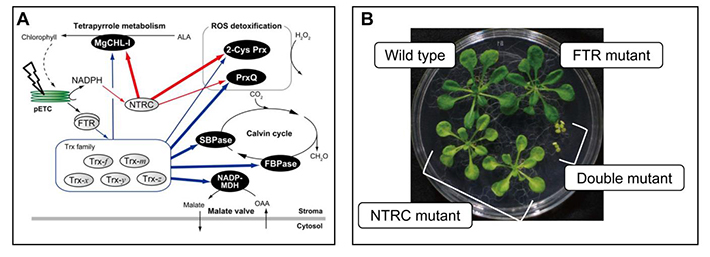Scientists at Tokyo Tech have identified two redox cascades that cooperatively regulate chloroplast function and contribute to plant survival.
A fundamental challenge of the plant life cycle is how to manage fluctuating environmental conditions. To preserve the integrity and efficiency of photosynthesis, chloroplasts have evolved multiple adaptive strategies to changes in light environments. The thiol-based redox regulation system is important for controlling chloroplast functions in response to light signal. This system has been traditionally considered to be supported only by ferredoxin-thioredoxin reductase (FTR)/thioredoxin (Trx) redox cascade. However, emerging genomics and proteomics data indicate that chloroplasts have a complex redox network, not a simple one-directional cascade.
In this cutting-edge study, Yoshida and Hisabori have identified another pathway that works differently but collaboratively with FTR/Trx to regulate chloroplast functions. They show that NADPH-Trx reductase C (NTRC), a unique redox mediator harboring both a NADPH-Trx reductase domain and a Trx domain, plays a distinct role in regulating chloroplast functions and discuss how the cooperative functions of the two redox pathways maintain plant viability.
The scientists employed NTRC-affinity chromatography and biochemical methods to identify molecules targeted by NTRC in spinach chloroplasts. While NTRC and Trx proteins recognized some overlapping targets, their interactive affinities and reducing activities were different. Moreover, NTRC specifically bound Trx-z, one of the Trx proteins, and transferred the reducing power to this unique target. The deletion of NTRC resulted in pale green leaves, suggesting an important role of NTRC in plant growth. Moreover, further impairment of FTR accumulation was lethal under autotrophic conditions, underscoring the critical importance of the concerted activity of these pathways for plant viability. Since these redox systems can derive signals through different sources (FTR/Trx pathway is exclusively dependent on the light-driven photosynthetic electron transport and NTRC can function even under dark conditions), their integrative functioning significantly contributes to transmitting signals from diverse environmental cues. These breakthrough findings indicate that cooperative redox regulation by the highly organized network comprising FTR/Trx and NTRC (shown in Figure 1) is essential for chloroplast functional activity and plant survival in varying environmental conditions. Further studies will help elucidate the intricate interplay of these redox networks.

Figure 1. A. Proposed model of the chloroplast redox network. The NTRC and Trx families have distinct target proteins (red arrows and blue arrows, respectively). They have different reducing power transfer efficiencies for common targets (represented with varying thickness of arrows). B. Phenotypic effects of mutating FTR/Trx only, NTRC only, or FTR/Trx and NTRC. Absence of NTRC results in pale green leaves and absence of both FTR/Trx and NTRC results in stunted growth. As published in PNAS.
Reference
Authors: |
Keisuke Yoshida1,2 and Toru Hisabori1,2 |
Title of original paper: |
Two distinct redox cascades cooperatively regulate chloroplast functions and sustain plant viability |
Journal: |
Proceedings of the National Academy of Sciences of the United States of America |
DOI: |
|
Affiliations: |
1Laboratory for Chemistry and Life Science, Tokyo Institute of Technology
2Core Research for Evolutional Science and Technology (CREST), Japan Science and Technology Agency (JST) |
. Any information published on this site will be valid in relation to Science Tokyo.




